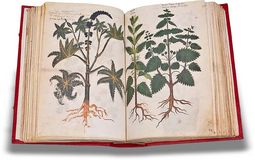Medicine
Medieval medicine has a poor reputation today, suffering from the negative connotations of the word “medieval” and the prejudice of modern doctors who tend to disregard the hard-won knowledge of their predecessors or anything that does not line up with modern Western medicine.
However, more recent trends in Western medicine, such as the embrace of holistic medicine and the discovery of useful plant-based remedies in medieval manuscripts, has begun to change this perception. Modern researchers increasingly see the Middle Ages as a period of advancement in medical science building on traditions from antiquity, especially the work of Pedanius Dioscorides, a Greek physician employed by the Roman Army.
As such, medical schools have begun to study the methods of physicians from centuries past like Abu al-Qasim al-Zahrawi or Avicenna. Aside from being useful, these medical treatises contain beautiful miniatures depicting both plants, animals, and the human body while also giving valuable insights into daily life in the Middle Ages. Some, like the Codex of Medicine of Frederick II, were even the personal commissions of health-conscious kings and emperors.
Demonstration of a Sample Page

Codex of Medicine of Frederick II
Treating Shingles
Shingles is a viral disease causing painful rashes and blisters on the skin, which can last for weeks. Not only is it related to the childhood disease chickenpox, but shingles is actually a reactivation of the virus. This advanced knowledge of the inner workings of the affliction were naturally unknown to medieval physicians, who instead focused on treating the symptoms.
Just like modern patients, a medieval person afflicted with shingles was first and foremost concerned with alleviating its painful rashes and blisters because a vaccine was many centuries away. Chamomile, oregano, and other plants were used to create a soothing salve, which is shown here being applied to the red-spotted legs of the patient by a kneeling physician in a green tunic.








